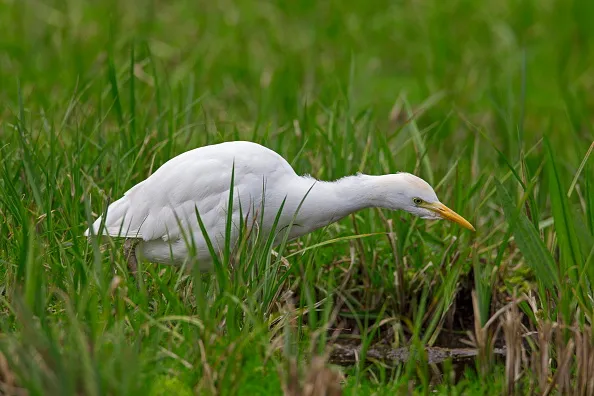Herons are a common sight in the UK, often seen perched on the bank of a river or lake, or hunting for fish in wetlands and marsh. You may even see a heron fishing in your garden pond. But there are a number of other bird species that resemble these tall icons of the British countryside, including cranes, spoonbills, egrets and bitterns.
Learn more about the differences between Britain's bitterns, herons, egrets and cranes – the stealthy hunters of our marshes and rivers – with our handy guide to the main species you can see in the UK, plus cousin species.

What is the difference between a bittern, egret and a heron?
Bitterns, herons and egrets are closely related birds of wetlands and rivers. Herons and egrets tend to be statuesque birds, with long legs for wading into deeper water in search of prey.
Bitterns are more squat, and hunt by blending into reedbeds and catching small creatures by stealth. All have long, dagger-like bills for spearing prey.
How to identify cranes, egrets, herons and bitterns
Great white egret

The size and shape of a grey heron but pure white except for black legs and a bright yellow dagger of a beak – easy to spot, even at long distances. Increasing numbers of great white egret are wintering on marshlands and lakes throughout Britain and there have been successful breeding attempts on the Somerset Levels and in eastern England.
Grey heron

A common and surprisingly big fish hunter found on almost every waterway. While wings and body are grey, the head it white with a black eyebrow and ragged black tassles. Nests in noisy colonies in tall trees. Ponderous but impressive in flight when it emits a loud “fraannk” call. Will hunt on land for rodents and frogs.
Bittern

Beautifully camouflaged fish and frog hunter of reedbeds and rushes. Numbers and range in the UK have increased extraordinarily in recent years though it remains hard to see except on dusk flights to its roosting sites. In spring, its fantastically deep, hooting call reverberates across its wetland habitat.
Little egret

Another heron whose numbers and range are sharply on the rise over the past 30 years and it can now be seen anywhere from tiny urban streams to mighty reservoirs and bleak estuaries. Two thirds the size of the great egret, it has a black legs and rapier-like bill. Its plumage is brightly white with long head tassels.
Cattle egret

Slightly smaller than the little egret and with a fiery orange crest and chest, this heron is more commonly found around livestock in wetland areas, feeding on creature disturbed by the mammals’ hooves. Still a relatively rare sight in Britain but increasingly common and beginning to breed at several locations.
Spoonbill

A very large heron like bird that hunts small creatures using its bizarre spatula-like bill to sieve tasty morsels from the water, sweeping its head from side to side. Hence it is a much more moble feeder than the stealthier herons. Its range is spreading north and in the past five years, several pairs have bred successfully in southern England.
What do herons and bitterns eat?
Herons will mostly eat fish, particularly eels, but will eat frogs, voles and ducklings if they can catch them. Bitterns also eat fish but will take small invertebrates, tadpoles, frogs and newts.

Why are we seeing more heron, bittern and egret species in Britain?
In recent years, great white egrets, cattle egrets and spoonbills have all begun nesting in the UK in greater numbers, while populations of little egrets have rocketed. The key reason may be climate change and global warming, which is enabling southern species to find an ecological niche further north than before. Also, the UK has had some major conservation successes in restoring wetlands in Somerset, East Anglia and elsewhere and this has certainly helped bitterns recover from near extinction in the early 20th century.
heron cousins in the UK
White stork

A huge bird with a stout orange bill, the white stork is a cousin of the heron and a voracious hunter of frogs and voles in wet meadows and marshes. It appears almost stocky in comparison to the slender herons. Relatively common in northern France and each year a few individuals have drifted over to the UK each year. The White Stork Project has begun a reintroduction on several sites in south-east England with the famous rewilding Knepp Estate reporting several nests this year.
Common crane

Although resembling a heron, the common crane is not closely related. Although it shares the long next, bill and legs, it has a major difference. When in the air, it flies with an outstretched neck – herons fly with neck curled towards the body. Common cranes became extinct in the UK in the 19th century but returned naturally to the Norfolk Broads, where a small but expanding population exists. The Great Crane Project has been releasing cranes onto the Somerset Levels in the hope of establishing a permanent population there.
